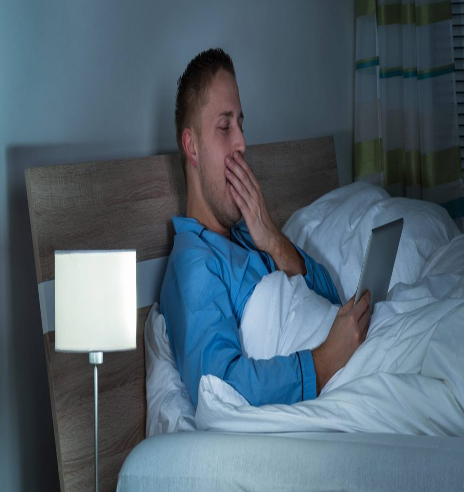By Dana McMahan
From phone-controlled smart lightbulbs to temperature-controlled pillows and mattress pads, technological innovations are helping people get more shut-eye.
Sleep eludes millions of Americans. Not getting enough sleep can lead to health problems, car crashes, accidents and errors at work, and just plain exhaustion. According to the Centers for Disease Control and Prevention (CDC) more than a third of adults are affected by this massive sleep debt. The problem is only getting worse.
While technology is often the culprit behind a sleep deficit, it can also help everyone catch more zzzz’s. Consumer sleep technologies are changing the landscape of sleep health and clinical sleep medicine, a recent study in the Journal of Clinical Sleep Medicine reported, and researchers said “over the counter” technologies such as sleep monitors are “here to stay.”
The study said that sleep-tracking products outsell health-tracking products on sites like Kickstarter. A recent search for ‘sleep apps’ returned over 500 different sleep related applications and one of the top five paid apps in 2014 was a sleep tracker and alarm clock.
The Benefits of a Good Night Sleep
Why is everyone so desperate for slumber?
“Sleep does so many things for us,” said Param Dedhia, an M.D. and director of sleep medicine at Canyon Ranch, a spa retreat dedicated to wellness.
Among innumerable benefits, sleep helps the body repair itself from the day, Dedhia said, adding that some of the benefits go beyond the physical body. Sleep also helps people work through emotions, imprint memories and engage in problem solving.
But how much sleep is enough?
“That’s the $10 million question,” said Nathaniel F. Watson, M.D., past president of the American Academy of Sleep Medicine (AASM) and a professor of neurology at the University of Washington in Seattle. Watson also co-authored the consumer sleep technology study.
The magic number is different for everyone, he said, but the AASM recommendation for adults is seven or more hours of sleep per night. For most adults, however, that’s just not happening.
“Sleep deprivation and sleep debt is rampant,” said Watson. “The CDC calls it a public health epidemic. If I could change a single thing in this country it would be to get people to prioritize sleep and sleep more.”
Dr. Watson and the co-authors of the sleep study however, can see a light at the end of the tunnel.
“Imagine a future where sleep information and technology is fully integrated into the home and into the consumer’s lifestyle,” the study said. “Users could set their sleep and wake times, and learn about ideal sleep durations from their smartphones.”
“I can envision when you walk into the bedroom, lighting is dimmed, blackout shades come down, temperature is adjusted to the perfect setting for your optimal sleep,” said Watson, imaging the perfect sleep conditions. “And you have a white noise machine that comes on at the right volume levels to block out ambient sounds.”
Many of these technologies are available or are underway now. Watson points to the S+ by ResMed. The sleep sensor pairs with a smartphone or tablet to help consumers track and understand their sleep patterns.
Most important to improving sleep, he said, is helping people get their sleep. The S+ provides tailored feedback based on sleep patterns and a user’s sleep environment, including the light, noise and temperature conditions. And a gentle alarm wakes the user during the right stage of sleep — light sleep — during a window they choose.
Thanks to these features, he explained, “It has been shown to increase sleep duration by 30 minutes.”
Using tools like S+ and sleep-tracking apps can be a useful means of getting people to pay more attention to their sleep needs, Dedhia said. “What I love about technology is that we can use it to keep the conversation moving forward; use this in a fun way so you can become curious.”
Setting the Scene for Successful Sleep
Similar to how people eat better when they start paying attention to their diets, or move more when they start wearing a fitness tracker like Fitbit, Dedhia believes people would get more and better sleep by tracking it. He also notes that, beyond measuring sleep, devices need to sooth the senses in order to create an environment that allows users to fall asleep.
Light is a common culprit in sleep issues, and while the blue light waves from devices can contribute to problems falling asleep, other types of light can be harnessed to improve the sleeping environment.
The C-Sleep LED bulb from GE automatically transitions from warm and calm light at night to crisp and vibrant in the morning.
Distracting noises, whether from traffic, neighbors or family members, can also disrupt sleep. Well beyond the typical white noise machine, Nightingale promises to mask those sounds with a smart home connected system that “blankets” a bedroom with sound customized for the room’s acoustics.
Temperature is another critical element to a good night’s sleep, and experts agree the sleep environment is best when it’s cool. Water-based cooling pillow pad Moona will regulate user’s pillow temperature to keep it cool while falling asleep, and warm to help wake up, and the ChiliPAD cube lets users set a mattress temperature as low as 55 degrees.
No matter how perfect the atmosphere is though, nobody’s falling asleep if they can’t turn down the inner volume. Users of the guided meditation app Deep Sleep with Dr. Andrew Johnson swear by the soothing voice.
There’s also the option to go old school and get a reminder that it’s bedtime. Tools including Google Now and iPhone’s Bedtime setting can give users a nudge that it’s time to turn off the TV or laptop and settle in for the night. With all these tools at users’ disposal, it seems ever-elusive sleep might soon be within reach.
